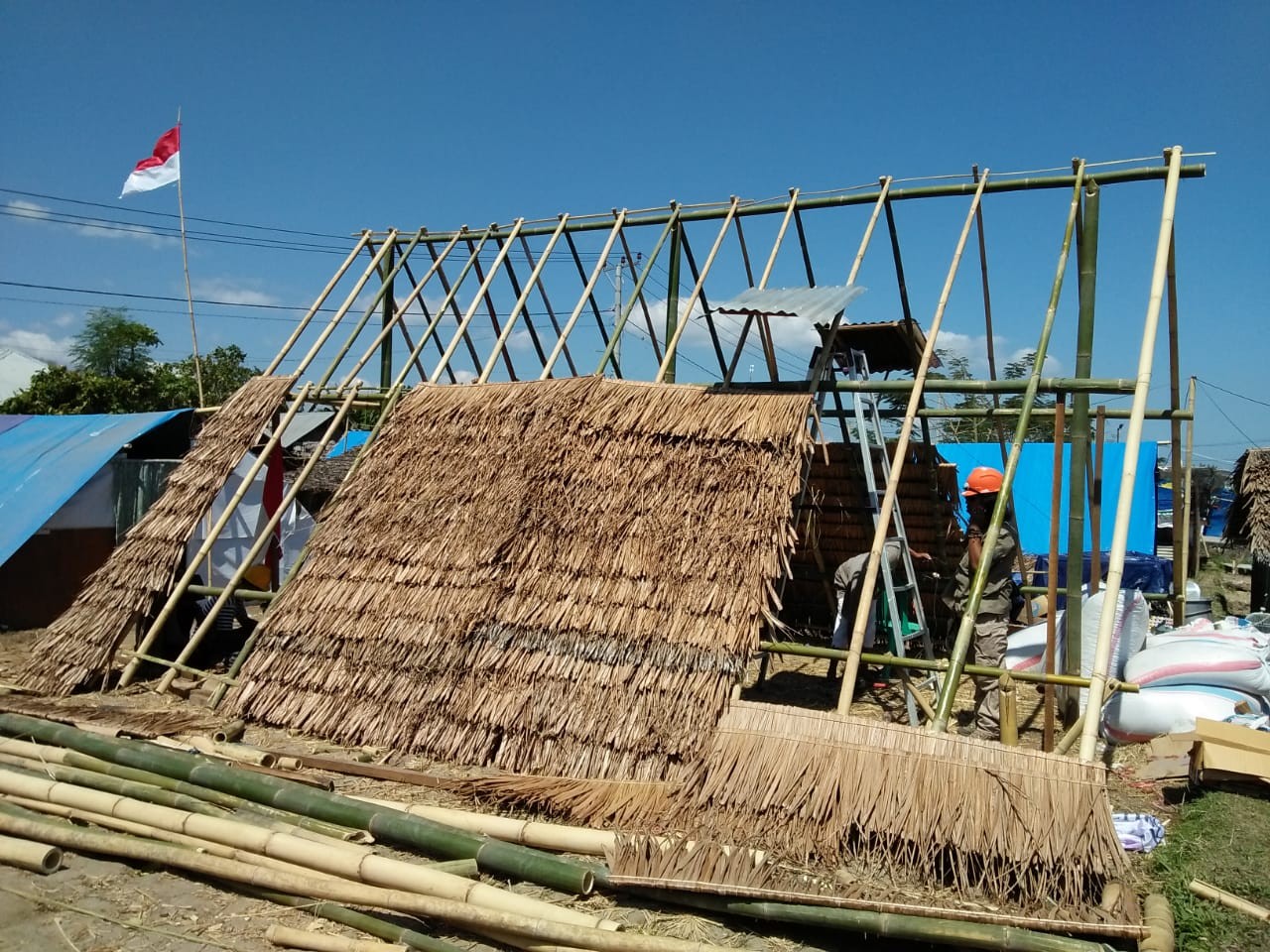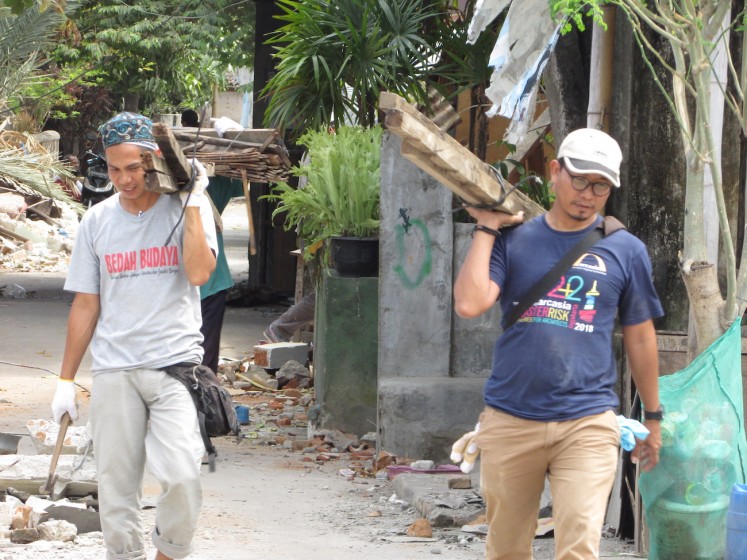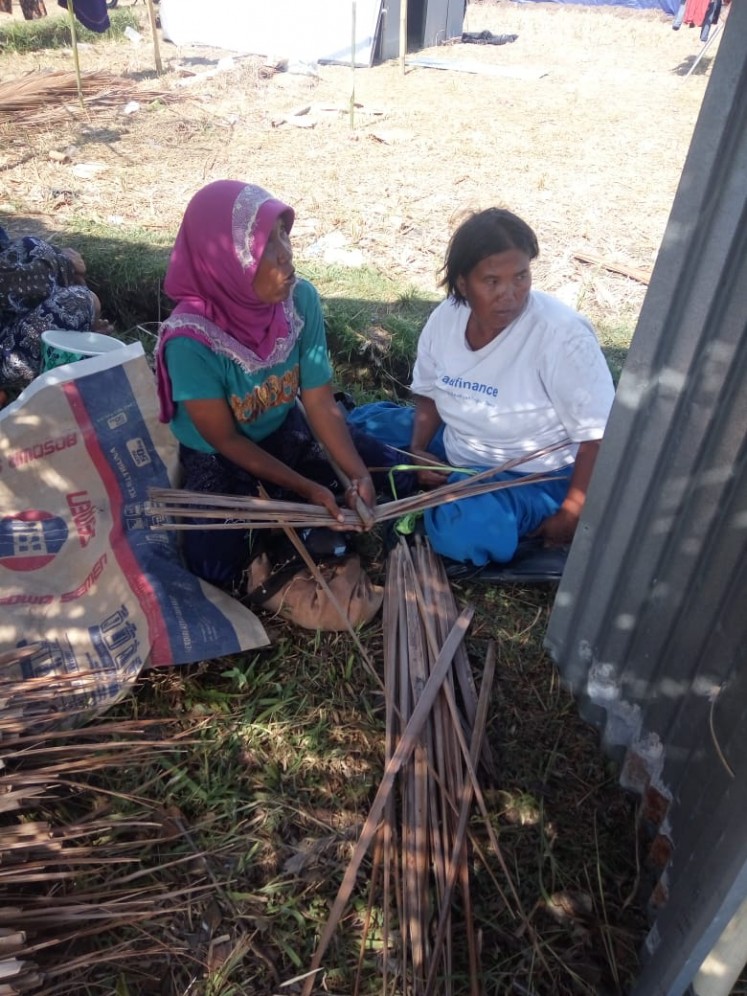Popular Reads
Top Results
Can't find what you're looking for?
View all search resultsPopular Reads
Top Results
Can't find what you're looking for?
View all search resultsQuake survivors use salvaged materials to build better shelters, rebuild lives
A volunteer architect spent a week with earthquake survivors on Lombok Island, where he witnessed their creativity, resourcefulness and resilience in rebuilding their lives after the devastation.
Change text size
Gift Premium Articles
to Anyone
T
he powerful 6.9-magnitude earthquake on Aug. 5 that destroyed thousands of houses on Lombok Island, West Nusa Tenggara, left the survivors so traumatized that many are afraid of looking at what is left of their homes.
Along with several volunteers from outside the province, I spent a week with survivors in their makeshift shelter and discovered their courage and spirit to overcome their circumstances. Instead of waiting for help from central government – which could take a long time to arrive, considering the scale of damage in the regency – they were working to build better houses for themselves,
Most of the survivors welcomed the government’s plan to distribute reconstruction aid for building permanent houses, but they will have to wait quite a long time for the cash, and they needed better temporary housing – and quickly.
The survivors I met took the initiative to so on their own, one that I believe deserves support from leaders like West Nusa Tenggara Governor Zainul Majdi. When a similarly powerful earthquake struck Yogyakarta in 2006, Governor Hamengkubuwono X supported such public initiatives and soon, the spirit to rebuild homes and lives reverberated throughout the province. The survivors worked together, using whatever they could salvage from the ruins and locally sourced materials to quickly erect better shelters for themselves.
Not sitting around waiting
I accompanied a group of women in Gondang village of North Lombok's Gangga district as they overcame their fear and walked about half a kilometer from their shelter to the ruins of their houses.
We entered the 2-meter-wide alley; to our left and right were ruins. The women began recalling the moment the earth shook and destroyed their homes.
Some of the women retrieved personal documents from among the debris; others recovered pots and pans. In one of the houses, debris had fallen onto a sewing machine and the rolls of fabric nearby.
One woman gathered the clothes that had been hanging out to dry when the earthquake struck. She only had a few items of clothing at the shelter, and she was happy to recover her own clothing.
“We have lost everything we had, our houses collapsed in ruins, and we are even afraid to look at them now. But we are together, and we are braver. Let us look at our house, save what we can save, and most importantly, not be afraid,” said Inak Asiyah, one of the women.
Asiyah and about 2,000 villagers now live under tents erected on harvested rice fields near Gondang Sports Hall.
In the village of Karang Subaga in West Pemenang district, Saeful Bahri lived in relief tents along with 3,600 other villagers near the North Pemenang Police station.
“It is impossible for us to just sit still in the tent. We will become more stressed out if there is nothing for us to do. We will get headaches,” said Saeful.
So Saeful and 24 other family heads came up with the idea to build temporary housing on their own, using materials salvaged from their damaged homes. Saeful had spoken to the village head for his permission to start building the temporary houses on their own on a plot of land they had selected.
Aside from the coming rainy season, the lack of sanitation and clean water has made their living condition worse, so there was an urgent need for a better place to stay.
Beginning to rebuild
On Aug. 25, the emergency response period ended and the post-disaster rehabilitation and reconstruction phase began.
About two weeks earlier, President Joko Widodo and several top officials visited several shelters in North Lombok, and he held a symbolic event in the regency to begin the government-led reconstruction program.
We must appreciate the intention behind this, but we will have to wait and see whether the permanent housing will be built fast enough to meet the needs of the earthquake survivors.
At the shelters, the survivors made their own calculations and arrived at a realistic conclusion. North Lombok Regent Najmun Ahyar said during a discussion at his residence in August that around 231,000 people in the regency had been displaced as a result of the disaster. The regency was paralyzed, he said, because the administrative offices, schools, health facilities and traditional markets had all been destroyed by the Aug. 5 quake. An estimated 23,098 houses would need to be rebuilt in the regency alone.
Overcoming fear
The survivors were not even sure that the government’s reconstruction program would begin immediately on Aug. 26 as planned.
A few days before the emergency period ended, I saw piles of rubble and debris that had yet to be cleared. Dozens of excavators, bulldozers and dump trucks had begun their work in some parts of Tanjung district. Hundreds of personnel from the Indonesian Military (TNI) and the National Police worked hard to help clear the rubble and debris.
But the damage in North Lombok is so extensive that clearing it will certainly take a while.
After an intense discussion, Saeful and other survivors set out to sift carefully through the debris. They had to determine how to salvage any building materials they found without causing any remaining structures to collapse, which could injure them.
They decided to salvage lumber, window frames and zinc corrugated roof sheets. They transported the materials by hand, walking about 500 meters from the ruins to the empty plot of land they had agreed on.
Their sweat reflected their strength and resilience. Once they had overcome their fear, the men grew more confident and were able to tap their creativity.
I observed how they erected their tents and saw that the villagers had some construction knowledge. They also had basic tools like saws, knives and pangot, an awl-like tool to make holes in bamboo poles.
Aside from the materials they salvaged, some men went into the forest to gather more bamboo while others were tasked with splitting the bamboo to create thin, long strips. The women later realized that they could weave palm leaves into roof panels.
Their relief tents gradually transformed into a better, taller shelter with distinct rooms and a kitchen area. Then the survivors turned to constructing communal facilities like gutters.
Earthquake survivors weave palm leaves into roof panels for their temporary houses on Lombok Island, West Nusa Tenggara. (Courtesy of Yuli Kusworo/-)Design intervention
This process made it easier for us architects who assisted the survivors in designing improved shelters for temporary housing while they waited for the government to rebuild permanent housing for them.
Together, we build a model of a temporary house made of bamboo and salvaged building materials. We were inspired by the tent frame the survivors had built themselves. We "intervened" with some adjustments to the design, suggesting an elevated floor, two windows and a higher roof.
While the survivors' original design used blue tarpaulin, we suggested they use other, salvaged materials to maintain a cooler interior temperature. We left the villagers to design the interior layout in accordance with their individual needs.
My fellow volunteer architects and I believe that with gotong royong – working together in a shared spirit of communal assistance – the villagers can more quickly overcome their traumatic experiences to rebuild their lives.
The writer specializes in community and social architecture, and is the founder of ArkomJogja, which focuses on post-disaster reconstruction and informal settlement rehabilitation.









